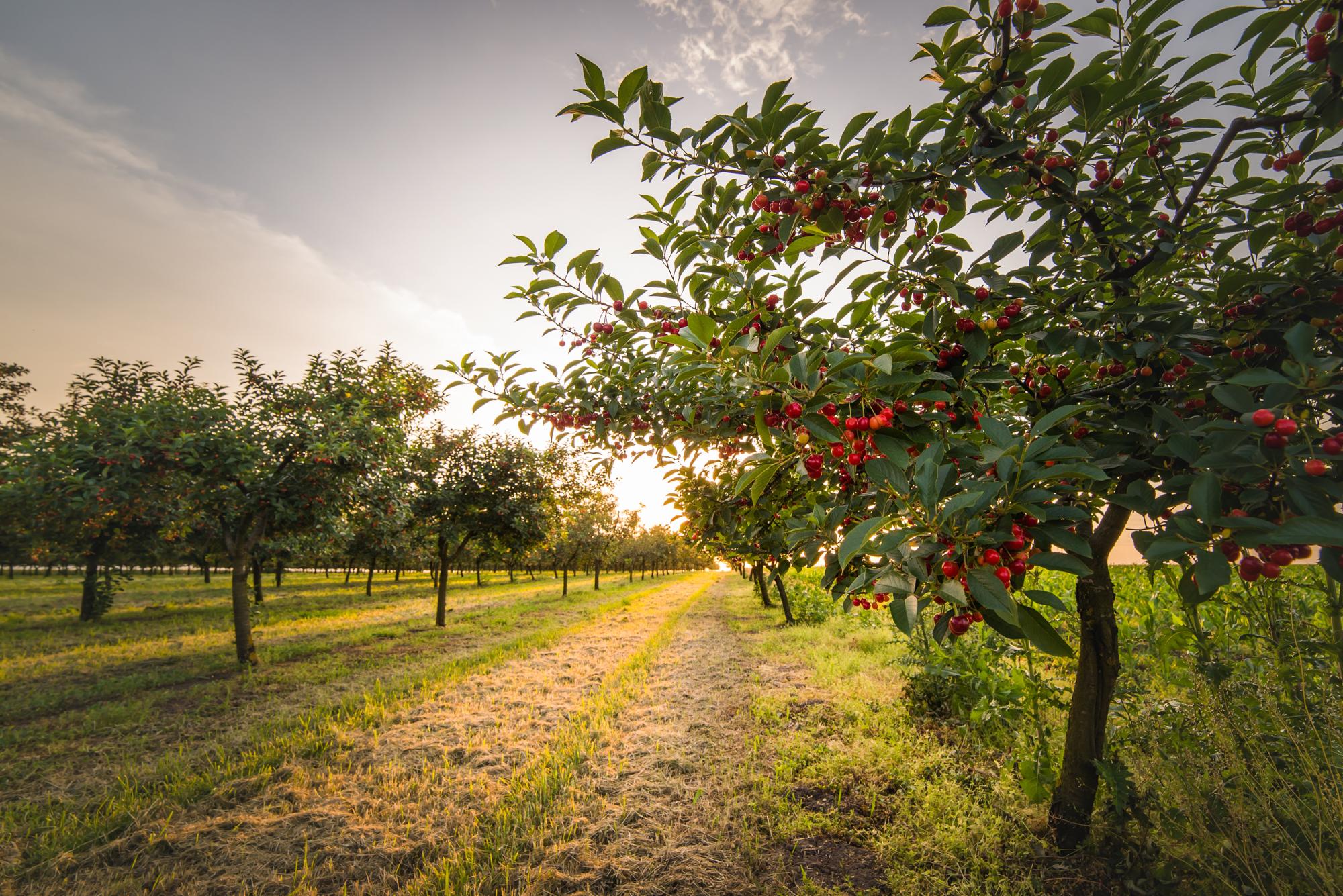Cherry Tree Training, Pruning, and Fruit Thinning

This post is also available in:
This post is also available in:
![]() Español (Spanish)
Español (Spanish) ![]() Français (French)
Français (French) ![]() Deutsch (German)
Deutsch (German) ![]() Nederlands (Dutch)
Nederlands (Dutch) ![]() हिन्दी (Hindi)
हिन्दी (Hindi) ![]() Türkçe (Turkish)
Türkçe (Turkish) ![]() 简体中文 (Chinese (Simplified))
简体中文 (Chinese (Simplified)) ![]() Ελληνικά (Greek)
Ελληνικά (Greek) ![]() Português (Portuguese (Brazil))
Português (Portuguese (Brazil))
How to prune Cherry trees
Like in most fruit trees, the cherry farmer can start shaping the young trees by generally pruning during the second year after planting. The decision to choose the final training scheme (tree shape) depends on the grafted variety and rootstock, the harvesting method, the yield goals, etc. Except for training, the farmer needs to prune the cherry trees yearly to maintain the balance between fruit/stem production, control the yield load, improve aeration and maintain the training scheme of the trees. In both cases, any pruning activities should be performed during late winter, when the trees are still dormant but after the period of extreme cold (frost danger).
Training of cherry trees
There are several commercially successful training systems for cherry trees: Kym Green Bush (KGB), Spanish Bush (SB), Steep Leader (SL), Upright Fruiting Offshoots “Y” Trellis (UFO-Y), Super Slender Axe (SSA), Tall Spindle Axe (TSA), Upright Fruiting Offshoots (UFO), and Vogel Central Leader (VCL). The most common and productive training schemes applied in commercial cherry orchards are the vase-shaped or open-center form, the fruiting wall, the modified central leader and the Super Slender Axe.
The first shape is very popular in sour or tart cherries. The tree consists of 3-5 main scaffold branches that develop from the central trunk and grow upright at a 50° to 60° angle from the trunk and 6-9 inches (15-23 cm) apart. The tree trunk should be kept short to facilitate harvest (24-30 inches or 61-76 cm). Each primary limb is usually separated into two secondary branches. This scheme allows good light penetration in the tree canopy.
Sweet cherries naturally have an upright growth, and shaping them as a fruiting wall (Upright Fruiting Offshoot (UFO)), super slender axe (SSA), or in a modified central leader form is quite an easy process. However, trellising (support with multiple wires) is necessary. In the UFO system, the final tree height will be around 3.5-4.5 m (12-15 feet). In the modified central leader system, the tree consists of a single main leader (trunk) and well-spread whorls of branches (6 to 8 inches apart, with the first to start 24 to 30-inches or 61-76 cm above the ground). Finally, the case of a super slender axe system can be used for super-high-density orchards. This system is preferred when dwarf and precocious rootstocks are used (like Gisela 5 and 3 or, in some cases, even Gisela 6 and 12). At the same time, the grafted variety (main variety) that will be chosen needs to have strong upright growth and be capable of producing fruits on the basal buds of 1-year-old shoots. Each tree has a lower yield than other training systems but gives fruits of superior quality and good size. You can find more step-by-step guidelines on how to train your cherry trees in the references below.
Pruning for yield
Growers prune mature cherry trees not only to maintain their shape but also to improve sunlight penetration and canopy aeration. Moreover, they prune mature cherry trees in order to remove weak, broken, diseased, or wrong-direction branches, encourage the formation of new flowering buds and stabilize fruit production (balance between vegetative growth and yield). The severity and way of pruning highly depend on the training system of our trees. Pruning bearing cherry trees for their flower-fruit production doesn’t require many interventions. The frequency of mature tree pruning is usually once every year, in late winter or early spring, while the trees are still dormant to avoid injuring them. It is important to avoid removing branches more than 5 cm or 2 inches in diameter. On the other hand, the cherry farmer should cut off branches that shade the fruiting spurs, and the fruiting wood. Lobs older than 3 years that are no longer productive should be removed.
Fruit thinning
Cherries are fruit trees with a very high percentage of flowers that finally produce fruits. Especially, cherries on dwarfing rootstocks tend to flower very heavily. This can lead to overset of smaller fruits per tree that will be sold at lower prices. Consequently, growers often remove a fraction of underdeveloped fruits in order to let the tree use its resources in a smaller number of fruits that will finally be bigger and thus be sold at higher prices. However, fruit thinning is not usually needed since most experienced farmers have pruned their trees during winter (dormancy) in a way to balance and control fruit production in spring-summer. Extra-complementary thinning might be needed in years with highly favorable conditions and high pollination-fertilization success. This may be performed either with light pruning while the trees are flowering (reduce the future fruit load and increase aeration within the tree canopy) or, later on, by removing small fruits by hand (very labor intensive).
References
- https://www.cloudmountainfarmcenter.org/education/grow-tips/growing-cherries/
- https://anrcatalog.ucanr.edu/pdf/2951e.pdf
- https://www.canr.msu.edu/uploads/resources/pdfs/cherry_training_systems_(e3247).pdf
- http://whatcom.wsu.edu/ag/documents/treefruit/pnw543.pdf
- https://digitalcommons.usu.edu/extension_curall/2131/
Cherries: Info, Facts, Nutritional Value & Health Benefits
Plant Information of cherries
10 Interesting Things About Cherries You Probably Didn’t Know
Growing Cherry Trees for Profit
Soil requirements, preparation, and planting of cherry trees
Cherry Tree Water Requirements
Cherry Tree Propagation and Pollination
Cherry Tree Training, Pruning, and Fruit Thinning
Cherry Tree Fertilization
Cherry Tree Pests and Diseases
Cherries Harvesting and Yield per Hectare – Do you pick cherries with the stem on or off?








































































